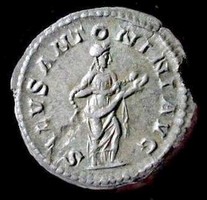Salus
was the personified Roman deity of health and prosperity. As
daughter of Aesculapius, she is also identified with Hygieia, Greek
goddess of health. Salus was responsible for the welfare of both individual and people (Salus Publica). Her festival was celebrated on March 30. |
| AD 161 - 180 |
 AD 218 - 222 |
AD 217 - 218 |
Under the Empire Salus Augusta was worshipped as protectress of
the emperors. On coins from Galba to Maximianus, she appears clothed in
a stola, either seated or leaning against a column and holding a sacred
serpent, feeding it from a patera. The serpent sometimes rises in folds
or is shown coiled around an altar. Depictions of Salus as reverse type were particularly popular with the Antonine rulers. Coins struck during their rule display a seemingly great concern for the welfare of the state. The denarius on the left, struck in honour of Faustina the Younger by Marcus Aurelius (adopted son of Antoninus Pius and a Salian priest at the age of 8), shows Salus standing left, feeding a serpent. The legend simply reads SALVS.The reverse on the right, from a denarius of the usurper Macrinus, depicts Salus seated, in a confident pose and feeding a serpent that rises from an altar. The legend reads SALVS PUBLICA. The coin in the centre, an antoninianus of Elagabalus (who had assumed the name Marcus Aurelius Antoninus to join the ranks of the Antonines), exhibits Salus in a very typical pose: she is standing, holding a serpent with her right hand, a patera in her left hand. The legend reads SALVS ANTONINI AVG (an allusion to the welfare of the Antonine rulers), perhaps ironically so for such an unpopular emperor who was to be murdered at the age of only eighteen. |